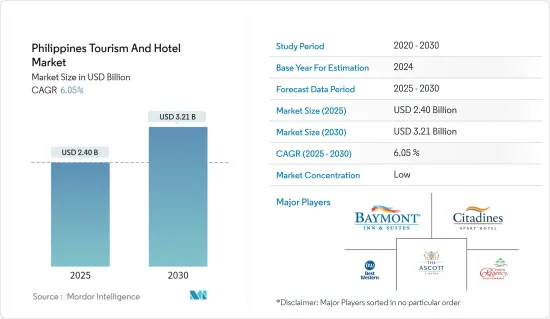PUBLISHER: Mordor Intelligence | PRODUCT CODE: 1628842

PUBLISHER: Mordor Intelligence | PRODUCT CODE: 1628842
Philippines Tourism And Hotel - Market Share Analysis, Industry Trends & Statistics, Growth Forecasts (2025 - 2030)
The Philippines Tourism And Hotel Market size is estimated at USD 2.40 billion in 2025, and is expected to reach USD 3.21 billion by 2030, at a CAGR of 6.05% during the forecast period (2025-2030).

The hospitality industry in the Philippines has shown significant growth and resilience, driven by the country's rich cultural heritage, scenic destinations, and favorable climate. This industry consists of a wide range of services, including accommodation, food and beverage, travel, and leisure activities, catering to both domestic and international tourists. The industry's expansion has been bolstered by increasing tourism, growing investments in infrastructure, and government support through policies aimed at boosting tourism and improving visitor experiences.
Noteworthy trends include a rise in eco-friendly and sustainable practices, reflecting global consumer preferences for environmentally conscious options. The proliferation of luxury and boutique hotels, along with diversified dining experiences, caters to varying customer preferences. Technological advancements, such as digital booking systems and smart hospitality solutions, are enhancing operational efficiency and guest satisfaction.
Challenges such as seasonal fluctuations, competition, and economic uncertainties persist but are being addressed through strategic innovations and enhanced marketing efforts. Overall, the hospitality industry in the Philippines remains dynamic and promising, contributing significantly to the country's economy and offering diverse opportunities for growth and development.
Philippines Tourism and Hotel Market Trends
Resurgence of International Air Travel in the Philippines Driving the Market
International air travel in the Philippines has shown a significant upward trend. Following an initial decline in international passenger numbers due to restrictions imposed during the COVID-19 pandemic, the segment experienced a strong rebound as these restrictions eased. This recovery aligned with the broader revival of global travel demand, driven by factors such as the easing of travel restrictions, enhanced health measures, and widespread vaccination efforts.
The substantial growth in international air travel demonstrates the resilience of the Philippine travel industry and indicates a strong economic recovery. As travel restrictions continue to relax and safety measures improve, the increasing international passenger numbers reflect a growing global interest in reconnecting with distant destinations. This rebound not only signifies recovery for the travel industry but also suggests renewed enthusiasm for international travel, supporting a positive outlook for the global tourism industry.
Robust Growth and Recovery in the Philippine Hotel Industry Aiding the Market
The Philippine hotel industry has experienced consistent growth in recent years, reflecting a strong recovery in the tourism and hospitality industries. This steady expansion has been driven by several key factors, including a surge in domestic tourism, relaxed travel restrictions, and increased traveler confidence. The Philippine government's active promotion of tourism and ongoing investments in infrastructure development have further supported the industry's growth.
Additionally, improvements in transportation, the rise of digital booking platforms, and the growing popularity of staycations have contributed to this growth. As a result, the Philippines has become a more attractive destination for leisure and business travelers, fueling consistent growth in the hotel industry.
Philippines Tourism and Hotel Industry Segmentation
The hospitality industry in the Philippines exhibits fragmentation, with a mix of international and local brands competing for market share. Ascott International targets business travelers and long-stay guests seeking premium serviced residences. Citadines, also under Ascott, offers modern, urban-style accommodations ideal for young professionals and short-stay visitors. Best Western and Baymont Inn & Suites provide reliable mid-range accommodations, appealing to a diverse range of travelers. Crown Regency Hotels & Resorts, a notable local player, combines luxury with unique experiences, attracting tourists looking for distinctive stays. These brands distinguish themselves through service quality, strategic locations, and unique offerings, contributing to the vibrant and competitive nature of the Philippine hospitality industry.
Additional Benefits:
- The market estimate (ME) sheet in Excel format
- 3 months of analyst support
TABLE OF CONTENTS
1 INTRODUCTION
- 1.1 Study Assumptions and Market Definition
- 1.2 Scope of the Study
2 RESEARCH METHODOLOGY
3 EXECUTIVE SUMMARY
4 MARKET DYNAMICS
- 4.1 Market Drivers
- 4.1.1 Investments in Infrastructure, such as Airport Expansions and Improved Road Networks, Enhance Accessibility and Attract More Visitors
- 4.1.2 The Rise of Online and Mobile Booking Services Makes it Easier for Travelers to Secure Accommodation, Driving Higher Occupancy Rates
- 4.2 Market Restraints
- 4.2.1 Natural Disasters, such as Typhoons and Earthquakes, Frequently Disrupt Travel and Damage Infrastructure in the Philippines
- 4.3 Market Opportunities
- 4.3.1 Government Initiatives Anticipated to Boost the Philippine Tourism Industry
- 4.3.2 Adoption of Advanced Technologies, such as Smart Rooms, AI-based Customer Service, and Digital Booking Platforms, can Enhance Guest Experiences and Operational Efficiency
- 4.4 Porter's Five Forces Analysis
- 4.4.1 Bargaining Power of Suppliers
- 4.4.2 Bargaining Power of Buyers/Consumers
- 4.4.3 Threat of New Entrants
- 4.4.4 Threat of Substitute Products
- 4.4.5 Intensity of Competitive Rivalry
- 4.5 Impact of COVID-19 on the market
- 4.6 Insights into Leading Cities in the Philippines with Respect to Number of Visitors
- 4.7 Insights into the Impact of Shared Living Spaces on the Hospitality Industry
5 MARKET SEGMENTATION
- 5.1 By Type
- 5.1.1 Business Tourism
- 5.1.2 Vacation Tourism
- 5.1.3 Eco-tourism
- 5.1.4 Cultural Tourism
- 5.1.5 Adventure Tourism
- 5.1.6 Event Tourism
- 5.2 By Tourist
- 5.2.1 Domestic
- 5.2.2 International
- 5.3 By Booking Channel
- 5.3.1 Phone Booking
- 5.3.2 In-person Booking
- 5.3.3 Online Booking
6 COMPETITIVE LANDSCAPE
- 6.1 Market Concentration Overview
- 6.2 Company Profiles
- 6.2.1 Ascott International
- 6.2.2 Baymont Inn & Suites
- 6.2.3 Best Western
- 6.2.4 Citadines
- 6.2.5 Crown Regency Hotels & Resorts
- 6.2.6 Scorpio Travel and Tours Inc.
- 6.2.7 Baron Travel
- 6.2.8 Vansol Travel & Tours
- 6.2.9 Marriott International
- 6.2.10 GoldenSky Travel and Tours*
7 FUTURE MARKET TRENDS
8 DISCLAIMER AND ABOUT US




